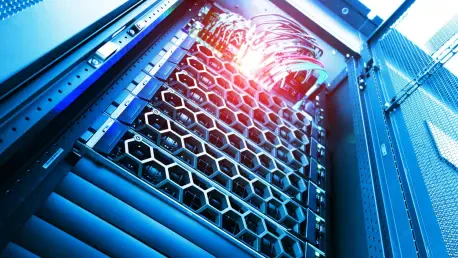In today’s rapidly evolving landscape of enterprise servers, Dell’s PowerEdge R7725 stands out as a formidable contender. Maryanne Baines, an authority in the cloud technology sector with extensive expertise in evaluating cloud providers and their offerings for a myriad of industries, shares her insights on this powerhouse server. Known for its incredible core density and flexibility, the R7725 caters to demanding workloads, but what truly sets it apart? In this conversation, we delve into the capabilities, features, and strategic advantages of the PowerEdge R7725.
Can you explain the target market for Dell’s PowerEdge R7725 and why it’s an appealing choice for them?
The PowerEdge R7725 is targeted at enterprises that require high-performance computing capabilities, such as those involved in big data analytics, AI/ML, and HPC. Its appeal lies in its ability to consolidate workloads efficiently with its staggering core density, offering an unparalleled processing power housed in just 2U of rack space. It suits businesses looking to streamline their operations by replacing older equipment while boosting their processing capabilities.
What kind of workloads is the PowerEdge R7725 designed to handle?
This server excels at handling resource-intensive tasks like big data analytics, AI and machine learning, high-performance computing, and virtualization. Its robust configuration, powered by AMD’s EPYC processors, ensures that it can support demanding applications with ease, making it a versatile choice for modern enterprises.
How does the PowerEdge R7725 achieve high core density in a 2U rack space?
The high core density is primarily achieved through its dual-socket design utilizing AMD’s EPYC 9005 CPUs. This allows the server to support up to 384 physical cores in just 2U of rack space, making it one of the most densely packed options available for enterprises looking to bolster their data center capabilities without expanding their physical footprint.
Could you describe the storage configurations that the R7725 supports?
The R7725 offers a wide range of storage configurations, supporting up to forty E3.S Gen5 NVMe SSDs. This flexibility allows enterprises to tailor the storage capacity to their specific needs. Additionally, it accommodates the integration of up to 24 SFF SAS/SATA drives, giving businesses multiple options to suit various data storage requirements.
What are the capabilities for expanding the PowerEdge R7725?
Expansion is one of the R7725’s standout features, offering up to eight PCIe Gen5 slots and dual OCP 3 slots. This combination provides ample opportunity for businesses to enhance their server with additional components, ensuring the system can adapt to growing or changing operational needs over time.
How does the server support AI workloads in terms of GPU capabilities?
The PowerEdge R7725 supports up to two 400W double-width or eight 75W single-width GPU cards, which are pivotal for AI workloads. This capability ensures the server can handle the computational demands of AI tasks effectively, catering to businesses investing heavily in AI and machine learning initiatives.
Can you explain the cooling options available for the R7725, especially the direct liquid cooling kits?
The R7725 includes Dell’s DLC kits, allowing for direct liquid cooling, which enhances cooling efficiency for systems with more demanding specifications. This method removes excessive heat quietly and reliably, critical for maintaining performance and longevity in high-density server environments.
What is the role of Dell’s Smart Cooling technology in the PowerEdge R7725?
Dell’s Smart Cooling technology optimizes air-cooled setups, enabling the R7725 to efficiently manage thermal conditions for most configurations without the immediate need for liquid cooling. This feature is particularly beneficial for businesses that want to defer or avoid the complexities associated with liquid cooling systems.
How does the R7725 accommodate businesses that aren’t ready for liquid cooling?
For businesses not yet prepared for liquid cooling, the R7725 can still utilize air-cooling technologies. With options such as T-wing heatsinks and high-performance Platinum fans, it maintains the system’s efficiency under typical workloads, offering a gradual and adaptable path toward future cooling upgrades.
What storage options does the R7725 offer in terms of drive types and quantities?
Besides the forty NVMe SSDs, the R7725 can house up to 24 SFF or 12 LFF SAS/SATA drives. Enterprises can mix NVMe with SAS/SATA options to create a customized balance of speed, capacity, and cost-efficiency suitable to their specific operational needs.
Explain the RAID options available with the PowerEdge R7725.
With the R7725, Dell offers a range of RAID solutions through its PERC RAID controllers, from the entry-level fPERC H365i to the high-performance PERC13 H975i. These options provide robust storage acceleration, particularly beneficial for AI workloads that require rapid data accessibility and redundancy.
How does the BOSS-N1 DC-MHS adapter enhance data storage flexibility for the R7725?
The BOSS-N1 DC-MHS adapter significantly enhances storage flexibility by providing dual hot-plug M.2 NVMe SSD slots. Enterprises can use these slots for boot purposes, freeing up the main storage for core data operations and improving overall data accessibility and system performance.
What features does the iDRAC10 remote management system provide?
Dell’s iDRAC10 is pivotal for remote server management, offering comprehensive features like multi-factor authentication and integrated Root-of-Trust encryption. It supports detailed monitoring of server operations and health, allowing IT teams to manage and maintain servers with ease from anywhere.
Describe the security features introduced by the iDRAC10 with this server.
The iDRAC10 introduces enhanced security with features like a dedicated security processor with a cyber-resilient architecture. It offers hardware integrity verification, robust encryption, and firmware attack prevention, ensuring the server remains protected against evolving cyber threats.
How is server management separated from the motherboard in the R7725?
The server management functions are separated from the motherboard by incorporating them into a DC-SCM, allowing Dell to update and enhance management features independently. This approach provides a modular and flexible management solution across their server range.
Could you explain the integration of Dell’s OpenManage Enterprise software with iDRAC10?
OpenManage Enterprise integrates closely with iDRAC10, providing a unified platform for server management. It allows for discovery, monitoring, and control of Dell servers while also acting as a collector for data transmitted to Dell’s APEX AIOps Observability platform, ensuring seamless infrastructure management.
What is the purpose of Dell’s APEX AIOps Observability platform, and how does it connect with the R7725?
Dell’s APEX AIOps Observability platform provides a cloud-hosted solution for infrastructure management, which connects with the R7725 via OpenManage Enterprise. It facilitates real-time monitoring, telemetry, and advanced analytics, empowering IT teams to optimize operations and predictably manage infrastructure.
How is the pricing structured for the PowerEdge R7725, and what factors contribute to higher costs?
The R7725’s pricing varies significantly, starting around £13K and rising sharply depending on configuration options like CPU, memory, and storage. High-density components, such as those designed for robust AI applications, contribute to increased costs, but the price reflects the intensive capabilities the server offers.
What return on investment can enterprises expect from the PowerEdge R7725?
Enterprises investing in the R7725 can expect substantial ROI through enhanced productivity and reduced operating costs. By consolidating processing power into fewer units, businesses can free up rack space, improve operational efficiency, and accommodate future growth with minimal additional investment.
Why is it beneficial for enterprises to replace older servers with a system like the PowerEdge R7725?
Replacing older servers with the R7725 can dramatically improve performance, lower energy consumption, and reduce physical space requirements. The server’s advanced capabilities ensure it can support modern workloads more efficiently, making it a prudent long-term investment for enterprises focused on technological advancement.
How does the R7725 contribute to freeing up valuable rack space in data centers?
By offering a high-density configuration with AMD’s latest processors, the R7725 concentrates significant processing power into a compact form factor. This consolidation leads to fewer racks needed, which not only saves space but also simplifies infrastructure complexity within data centers.
Could you summarize the main strengths and potential limitations of the PowerEdge R7725?
The R7725’s primary strength lies in its unmatched core density and flexibility in handling diverse workloads. It supports extensive expandability and cooling options and offers robust remote management features. However, its main limitation could be the upfront cost, as the advanced configurations might be prohibitive for smaller enterprises or those with tight budgets.
Do you have any advice for our readers?
For enterprises evaluating their server infrastructure, it’s crucial to consider not just current needs but also future growth. A server like the R7725 might demand a significant investment upfront, but its ability to consolidate operations, handle high-performance workloads, and reduce physical space can prove invaluable as your business evolves.









